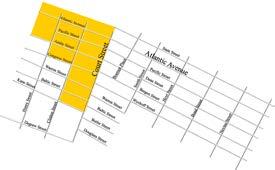SPRING 2016
Commercial and Industrial Character While initially characterized as a town or a village, Brooklyn was first referred to as a city beginning in 1834. At this time, the formerly rural character of Brooklyn began to change. Farmland was gradually replaced by warehouses and factories. As this newly formed industry grew, infrastructure developed around it with the establishment of the LIRR. The rail line was intended as a shipping route with the ultimate goal of connecting New York to Boston and facilitating the easy transport of goods.1 Brooklyn’s waterfront south of Atlantic Avenue also began to develop as an important industrial area at this time. The ports not only allowed for commuting between Brooklyn and Manhattan and served as an arrival point for various immigrant groups, but they also represented important commercial shipping routes. By 1900, ferry docks, warehouses, factories, and pier sheds lined the Brooklyn waterfront. The New York Dock Company, which controlled much of the area after 1901, built many new buildings and warehouses to house the massive amounts of cargo and commercial goods that were arriving from all across the world. The 1904 land use maps for Cobble Hill and Boerum Hill show not only that the amount of industry in the area had increased significantly since the late 1800s, but also that a greater diversity of industries was present. There were seventeen locations related to the wagon and carriage industry, fourteen locations related to metalworking, eleven carpenters, one candy factory, one underwear factory, and one brewing company. According to the maps, industry tended to be located in proximity to major lines of transportation, namely along Atlantic Avenue, Court Street, and Smith Street.
After the 1916 zoning law called for the separation of uses, industry began to move towards the outer perimeters of what would eventually become the Cobble Hill and Boerum Hill Historic Districts. The 1929 map reveals not only this movement of industry, but also the decline of the carriage industry, corresponding to the rise of the automobile and automotive industry. By the time of the Cobble Hill designation in 1968, all of the industry had moved outside the borders of the districts. Today, essentially all of the industry is completely gone from the area.
1 http://www.lirrhistory.com/lirrhist.html
72 Changes in the Built and Social Fabric




















